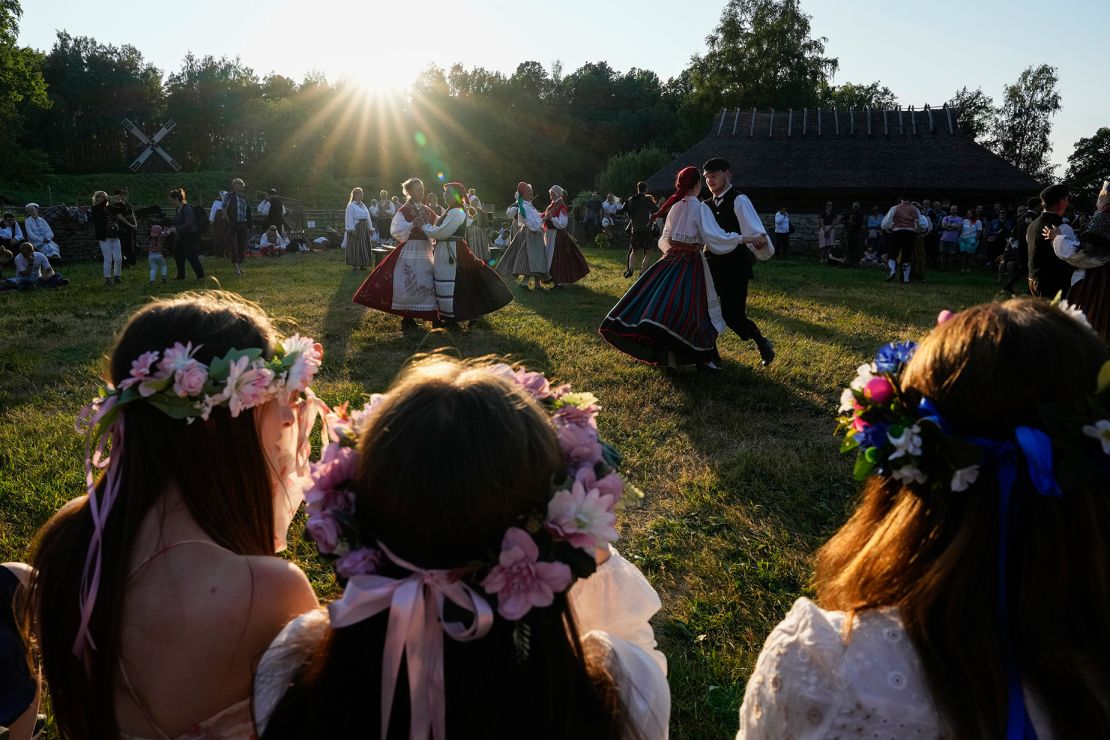DALLAS (AP) — It’s time for the start of summer — with a full moon to boot.
Here’s what to know about the summer solstice in the Northern Hemisphere on Thursday.
What is the summer solstice?
The Earth spins on a tilt as it revolves around the sun. The summer solstice occurs for Earth’s upper half when the Northern Hemisphere is tilted most closely toward the sun. This also marks the longest day and shortest night of the year.
Around the same time, the Southern Hemisphere is at its most extreme tilt away from the sun, entering winter solstice and its shortest day of the year.
Six months later, the halves will switch it up: The Northern Hemisphere will experience a winter solstice, and the Southern Hemisphere will have a summer solstice.
What is an equinox?
Equinoxes mark the start of spring and autumn, and happen when Earth’s axis and orbit line up such that both hemispheres get an equal amount of sunlight.
The vernal equinox on March 19 kicked off spring, and the autumnal equinox on Sept. 22 will usher in fall.
What is the strawberry moon?
This year’s summer solstice comes with a treat: the first full moon of the summer, coined the strawberry moon. The moon won’t be pink or red in color: Its name comes from several Indigenous tribes who noticed that its timing coincided with the strawberry harvest.
On Friday evening, cast your eyes to the southeast to glimpse the full moon peeking above the horizon.
Do you yearn for long days and short nights? Then this could be the best day of the year for you and your fellow sunlight seekers.
The summer solstice is Thursday, June 20. It’s the longest day and shortest night in the Northern Hemisphere. It’s also the first official day of summer.
Our ancient ancestors certainly took note of the yearly occasion. Some of their monuments were aligned to precisely mark the summer solstice light (looking at you Stonehenge).
Pagan celebrations of the day carry on into modern times. Events include gatherings at Stonehenge in England, the Midsummer Eve celebration in Sweden and Ivan Kupala Night in parts of Eastern Europe.
The mirror image of the winter solstice, the summer solstice is historically linked to fertility – both the plant and human variety – in destinations worldwide.
The science of the solstice and its traditions have fascinated people for millennia.
Summer solstice science

Is it summer solstice all over the world? No. It’s only in the Northern Hemisphere, where almost 90% of the world’s population lives. People south of equator in places such as Chile, South Africa and Australia are having their winter solstice and the shortest day of the year there.
When is the 2024 summer solstice exactly? It will fall at 20:51 UTC (Universal Time Coordinated) on June 20. Your local time zone in relation to UTC determines the time and even the date that the solstice happens for you. For instance, that’s 1:51 p.m. in Los Angeles, 4:51 p.m. in New York City, 9:51 p.m. in London and 5:51 a.m. June 21 in Tokyo. Earthsky.org has a handy time zone conversion tool.
Who gets the most sunlight? The differences in how much daylight you get become very dramatic as you get closer to the poles and farther from the equator. In Ecuador’s capital of Quito, barely north of the equator, people barely notice the difference. They get a measly extra six and a half minutes of daylight.

But residents of northerly Helsinki, Finland, will get a 3:54 a.m. sunrise and almost 19 hours of daylight. Even the night doesn’t get that dark. The denizens of Fairbanks in central interior Alaska can scoff at those 19 hours. They’ll get almost 22 hours of daylight, and blackout curtains might be in order.
Why don’t we just get 12 hours of daylight all year? Folks all over the planet actually did get nearly equal doses of day and night back during the spring equinox three months ago. But the amount of sunlight in the Northern Hemisphere has been increasing daily ever since. That’s because the Earth is aligned on an axis, an imaginary pole going through the center of our planet. But this axis tilts – at an angle of 23.5 degrees.
“As Earth orbits the sun [once each year], its tilted axis always points in the same direction. So, throughout the year, different parts of Earth get the sun’s direct rays,” explains NASA. When the sun reaches its apex in the Northern Hemisphere, that’s the summer solstice. After that, the days start getting shorter again until we reach that 12-hour day/night split in the the fall equinox.
Is this also the hottest time of year? Generally, it’s not, although this week is a scorcher in much of the US.
“On average, the vast majority of the United States experiences its warmest temperatures in July or early August,” says CNN Senior Weather Producer Taylor Ward.
“Temperatures essentially continue to rise after the summer solstice because the amount of energy coming in from the sun continues to be greater than the amount of energy lost at night – so it is basically an accumulation of warmth until the daylight gets short enough that this changes,” says Ward. “The only area of the country that actually sees their warmest temperatures in June, coinciding with the longest daylight of the year, is portions of the Southwest” because of the timing of the cloudy monsoon season there in July and August.
The same general temperature pattern holds true in places such as Japan and much of Europe.
How to celebrate summer solstice
What does Stonehenge have to do with the summer solstice? The ancient stones of the monument in Southwest England dating to around 2500 BC were aligned by its makers astronomically.
The central axis of Stonehenge was aligned with the sunrise at summer solstice and sunset at winter solstice so that the stones precisely frame the rising and setting sun when days were at their longest and shortest. And it still works like clockwork in modern times.
The English Heritage society organizes gatherings at Stonehenge for the summer solstice and produces a livestream of the sunrise.

What other cultural traditions surround the summer solstice? In Sweden, the Midsummer Eve celebration is tied to the solstice, always being held on the Friday that lands anywhere from June 19 to June 25. Maypoles, folk dancing and romantic rituals are the order of the day.
In Ukraine and some other places in Eastern Europe, the summer solstice is connected with Ivan Kupala Night – a holiday with romantic connotations for many Slavs. People dance, place flowered wreaths on the water and gather around bonfires.
In India, the birthplace of the ancient practice of yoga, the summer solstice is traditionally celebrated with mass yoga sessions throughout the nation. And the United Nations’ International Yoga Day falls each year on the summer solstice.
Credit: Source link